Horses: The Most Beautiful Animals To Gallop The Earth
Horses have been the subject of human fascination for centuries. They’re beloved animals that have served humanity in many valuable ways, from agriculture and hunting to therapy. These beautiful creatures tend to be kept for sport, recreation, and hauling work, but some can still be found in the wild, even though they come from domesticated breeds.
Different horse breeds have a wide variety of characteristics. Even those we regard as commonplace have beautiful and unique traits. From the familiar solid brown horses to dapple gray and palomino horses, we will explore the beautiful possibilities our dear equine friends hold regarding their fabulous looks.
The “Moo” Horse
This horse reminds us a little bit of another beloved farm animal. The Pinto is partly dark and partly white, making it look like a slender Holstein Friesian cow, also known as the standard black and white cow. There are over seven different names to refer to the different patterns these beautiful creatures can have.
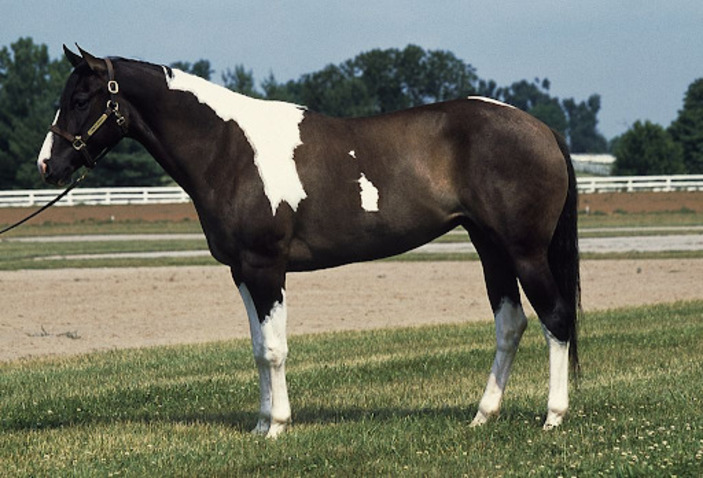
Source: DeAgostini/Getty Images
They are a relatively common variation and come from selective breeding to maintain the desired patterns. They are sometimes referred to as “paints,” but in the U.S., that is a specific breed, meaning that not all paints are, in fact, pintos.
Many Breeds, Many Traits
Horses come in many breeds, and these breeds have different characteristics. There are hundreds, and all of them have carefully selected features that distinguish them from one another or give them unique strengths or abilities.
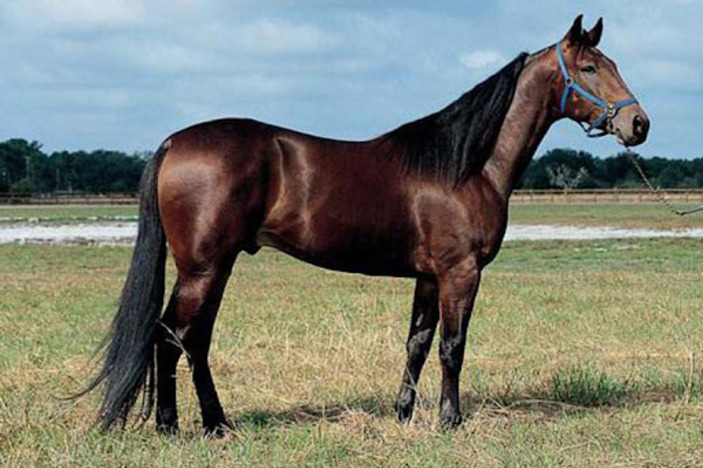
Source: Pinterest/tcchamber
For example, this standardbred is known mainly for its outstanding ability to take great speed when harness racing. But also for its beauty, an incredibly refined type. Just look at the way it stands proud and tall, with a solid, muscular body.
A Special Gene
The Sabino horse isn’t a specific breed but rather a gene. This means that many types of horses can have a bit of the Sabino 1 gene. The gene causes unique white, splashed markings on the coat specifically allocated on the belly, the face, and the legs, with some “splashes” of white around other parts of the body.

Source: @really_animals/Twiiter
This coating is unique because it is necessary to perform a DNA test to check if a horse is a real Sabino. After all, many other types, such as roans, can be mistaken for Sabinos. Some breeds that can carry the gene are hackney, mustang, American paint, Tennessee walking horse, and the miniature horse.
Not That Red
Ths red roan quarter horse has a beautiful speckled coat. The term roan means that this horse has a solid chestnut base color but intermingled white fur that gives it a curious shading effect—making it red-looking.
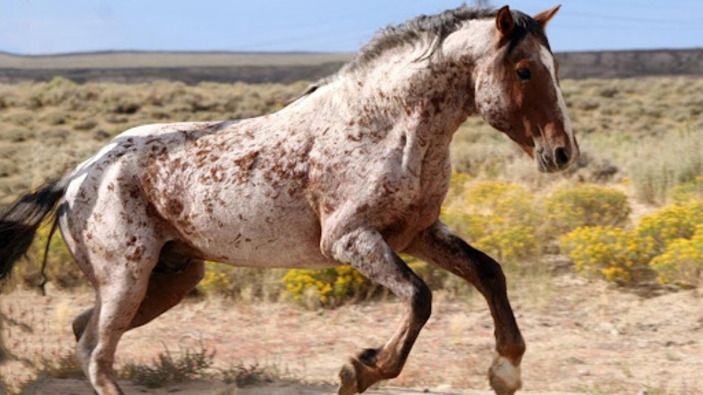
Source: YouTube/Top Animals TV
Sometimes it’s not noticeable when a horse is born a roan because of the foal (baby horse) coat they are born with. It isn’t until foals shed their coat that the roan becomes apparent, but once it’s there, it never fades, unlike gray horses.
A Young Dapple Gray
This youngling is a colt, the name for young male horses that aren’t yet mature, more youthful than five years old but older than two— in which case they are foals. The dapple gray is a type of coating with some extraordinary characteristics.
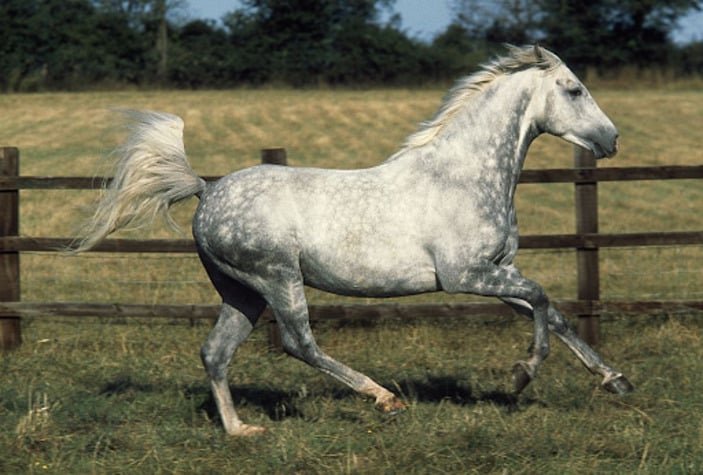
Source: DeAgostini/Getty Images
With his white “dapple” markings, this Arabian horse can still show off the deep gray undertones of his coat. But, eventually, he will lose them, and with age, they will fade into white hair. Most gray horses eventually turn white through the years, usually after they turn nine.
Proper English
This horse’s legs aren’t only meant for good looks. Thoroughbreds are an English breed of horses designed mainly for racing. They are “hot-blooded,” which means they have a great capacity for agility and speed.

Source: CHARLY TRIBALLEAU/AFP/Getty Images
Other physical traits thoroughbreds are known for are their thin, slender bodies, wide chests, and slightly short backs. These traits are useful when it comes to gaining speed. So now you know! If you find yourself at the racetrack, putting your money on a thoroughbred is a safe bet!
Dipped In
This is a beautiful horse because it looks as if someone dipped it into a bucket of white paint and didn’t bother coating the top! It is still in the “paint” breed of horses and is a fortunate fellow. Notice his little mustache under his nose? What an excellent-looking and gentle horse.

Source: @horse.colors/Instagram
This specific paint has become quite famous in online forums due to its peculiar look. Paints tend to be very docile and friendly. No wonder they were used by Indigenous Americans as a means of transportation. They’re also known for being strong, agile, and fast.
Shine Bright
What a beauty! Isn’t this horse just marvelous to look at? Its cream-colored coat shines like a star. This is called a “cremello” coat, and it is quite a very rarity. This gorgeous creature is a Turkmen horse breed known as Akhal Teke, one of the oldest breeds known to humanity.

Source: Wikimedia Commons
Cremellos have distinctively pink noses, rosy pink skin, and magnificent pale blue eyes, which only enhance their shine. They are not to be confused with the albino breed. The difference is that albino horses are born completely matte-white, and cremellos have a cream, lustrous tinge.
Arabian Beauty
Over 4,500 years ago, Arabian horses roamed around the Middle East in majestic, wild herds. They quickly became domesticated thanks to their gentle nature and quick learning abilities. Arab horses became some of the most sought-after breeds in the 80s due to their peculiar head shapes and high carried tails.

Source: Adam Guz/Getty Images Poland/Getty Images
Their rise in popularity affected their increase in dollars, and very quickly, Arabian horses became some of the most expensive horses in the market. Arabian horses are subject to many legends and ancient stories where they are portrayed as lucky omens.
Cremino’s Cousin Perlino
Although very similar in genes and looks, there are some differences between a Cremello and a Perlino—the most noticeable difference being that Perlinos have a darker mane than their skin, with a singular reddish hue. The contrast is very aesthetically pleasing for those seeking a majestic horse.

Source: @spanishhorseboutique/Instagram
These horses require extra care and attention because their skin is prone to sunburn and rashes. Apart from their mane color, the only other way to distinguish them is through DNA testing. The breeding method is fascinating; by selecting traits of specific genes, it’s possible to create certain patterns that will reflect on the horse. That’s why cremellos and perlinos are considered to be “double diluted.” They use two copies of the “cream” gene.
A Delightful Coat
We’re sure this one would steal fashion week if a horse’s coat could be considered haute-couture. This is a very rare phenomenon, but with gorgeous results, a combination of dapple gray and paint horse with a most beautiful full white mane. This is a showhorse with style.

Source: @horsefitshop/Twitter
This breed’s legs are “feathered”—feathers being the name for the long fur on his legs. This layer of hair provides extra warmth for the horse. Feathers are an evolutionary trait that surged with horses in icy cold places such as the United Kingdom and northern Europe.
A Wonderful Silver Buckskin
Regular buckskins have tanned deerskin coats and dark tails, manes, and lower legs. This buckskin has a singular gene mutation with a silver dapple gene, giving it a very distinctive look. What an elegant combination of a silver-gray body, gray socks, and a dark mane and tail. An exquisite combination!

Source: @thehorsetranslator/Instagram
Buckskins are considered a unique and even superior type of horse due to their remarkable strength and hardy build. This horse could easily be cast as a ghost in a fantasy movie because of its gorgeous white and dark contrast, exceptional frame, and appealing presence.
Bud’s Choice
Take a look at this Clydesdale horse! The perfect horse for anyone looking to catch everyone’s attention when trotting down the street. The hairs in its legs, called feathers, are a trait anyone who wants to use horses for parade carriages should look for. They’re so fancy!

Source: Ian Forsyth/Getty Images
These horses are magnificent, but unfortunately, the breed is vulnerable to becoming extinct. Because hauling power isn’t the main trait people are looking for in horses nowadays, Clydesdales aren’t in high demand. An interesting fact is that the company Budweiser has a breeding program because they use them as the symbol of their company.
The Movie Star
Palominos have been depicted in film and television for years. They became especially popular in western and fantasy movies. The distinctive gold coat and creamy white mane give Palominos a special allure. Compared to other coats, palominos are very rare.

Source: @senta_wolfsberg/Twitter
Palominos have been bred for centuries; they date as far as 14th-century Spain. Originally they were obtained by breeding a chestnut for its reddish hue, and a cremello, for the cream gene. Since breeding techniques have been refined throughout the years, palominos don’t fall exactly into the exact definitions we have nowadays, but they’re still highly regarded.
Spot The Horses
The appaloosas have a fiery temperament. They are an American breed that has been around for centuries. They’ve even been depicted in ancient cave paintings. Because of their leopard complex mutation gene, they have a dark spotting on their coats, fascinating horse lovers throughout the eras.

Source: Cuveland/ullstein bild via Getty Images
It isn’t infrequent to find leopard appaloosas, but they are much-loved for their sports abilities. They are highly proficient in western-style competitions and professional racing. A fun fact is that the appaloosa is the official state horse of Idaho.
The Definition Of Cute
This tiny equine is so small—who wouldn’t just want to cuddle it? This adorable specimen is a blanket appaloosa mini horse, which is even smaller than a pony. Ponies tend to be around 58 inches, with very different proportions than normal horses, like shorter legs and thick necks.

Source: @naturelover_s/Twitter
While miniature horses are genetically bred to resemble the exact proportions of full-size horses, they are up to 34 inches tall. They are kept for many reasons besides showing off in competitions. They are commonly kept as companion animals, and there is a growing demand for mini horses as service animals.
Golden Locks
It must be an absolute delight to comb this magnificent horse’s mane. It’s a natural beauty, this one. Flaxen mane is a genetic trait that makes the mane and tail much lighter than the coat color, frequently a golden bronze shade.

Source: @lindakjelland/Instagram
This particular horse has the body build fit for hard lifting work on a farm—or for movie stardom! The white markings on its face, also known as “stripe,” give this horse a lot of personality. They are unique identifiers that make each horse individually special.
The Tiger Horse
This is a rare specimen of horse that has a wonderfully striped mane. They go by the name of “brindled coat.” These incredible stripes are commonly found in other species, such as dogs, cats, and guinea pigs, but it’s highly uncommon to see this phenomenon in horses.
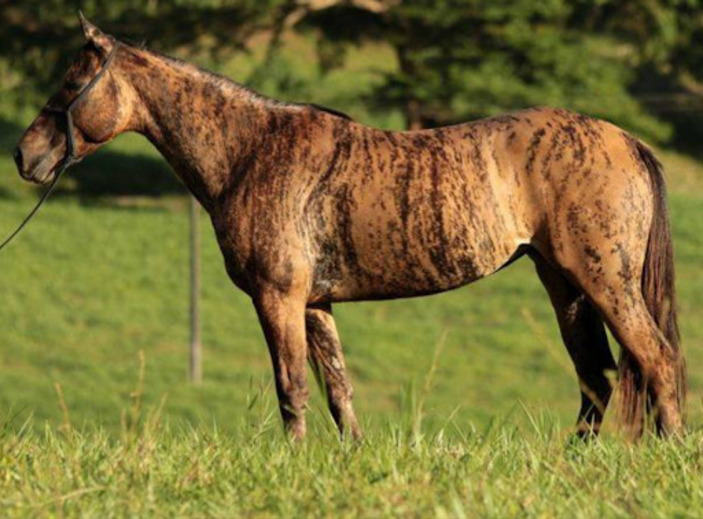
Source: @alabama_equine/Instagram
Unlike appaloosas or other spotted fellows, it is not easy to breed brindled horses. There haven’t been many studies on their genes. But this only makes them more desirable, and their price tag surely reflects that! But these aren’t even near the most expensive horses in the market.
Bubbly, Anyone?
This pretty boy is a gold champagne horse. What makes this specimen a rarity relies on its particular genes. There are important color shifts that make the peculiar coloring possible. For example, the DNA trait allows a chestnut-colored coat to turn gold with a flaxen mane.
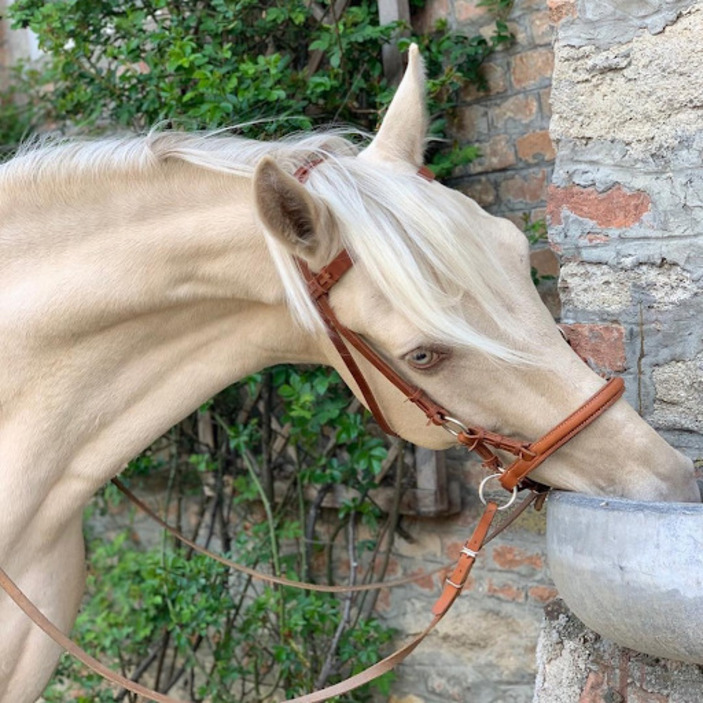
Source: @rosegolden_lusitano/Instagram
Champagnes can be mistaken for their good-looking palomino relatives. Their hazel or amber eyes give them away (palominos tend to have dark brown or black eyes). At least one parent must be champagne for a foal to be born with the lavish color, and there are DNA tests to check.
He’s Charming, And He Knows It
This rabicano is so beautiful, but some unique characteristics make it extra special. The white hairs on its tail and flank give this specimen a very distinct look. The almost skunk-type tail is one of the most recognizable traits of this breed.

Source: @StacyMichelleB/Twitter
Some equine breeders call this pattern “white ticking.” They’re different from roans since a rabicano’s white hairs are very specifically situated, but they can carry both genes. The horse pictured here has a few white hairs throughout its upper body that indicate it might have some roan ancestors!
A Blue Prince
What a majestic creature this is! An excellent example of a blue roan, a very beautiful type with similar genetic characteristics to their red-coated cousins, except that instead of having a chestnut base, they have a black hair base coat.

Source: @horseloverus24/Instagram
The blue tinge is amplified under certain lighting, making this a favorite amongst collectors and horse enthusiasts. They are the rarest of the roans, and their blueness sometimes isn’t apparent until they turn two or three years old. The pitch-black tail and mane give this beauty a spectacular zest.
One Of A Kind
What an outstanding foal! Look at that wonderful coat. The different colors suggest an unlikely blend of red roan, black roan, paint, and gray. It’s like somebody mixed in their favorite horse coats and got this as a result. We wonder how he will look throughout the years.

Source: @sso.coats/Instagram
Horses with lots of blends usually have one or two dominant genes that overshadow the others, but this horse hit the genetic pool jackpot. That white stripe is like a strategically placed brushstroke in an otherwise realistic painting.
101 Appaloosas
No, this isn’t just a big dalmatian version of a horse. This appaloosa is so beautiful, it looks like it’s blending with the white snow, but the black spots and streaked tail give it away. How spectacular!

We just hope Cruella De Vil isn’t looking to change her preferred quarry because this appaloosa could easily become the villain’s favorite. While dark appaloosas with white spots are very in demand, we have a soft spot for this cutie’s looks.
The Looks Of A Champ
Look at this horse’s elegance! Horses are wonderful animals that not only have endurance and speed but also are very intelligent. They have a good memory, which allows them to identify people around their environment, as well as solve problems that they might face.

Source: Fredo de Luna/VW PICS/Universal Images Group via Getty Images
This beauty is an American quarter horse, a breed of horse that is very popular in the U.S. The name comes from their ability to sprint and win quarter-mile races. They can reach extremely high speeds, up to 70 km/h. How impressive is that?
My Little Shetland
Friendly, loyal, and tiny! Who doesn’t love ponies? Aside from being extremely cute, Shetland ponies are very intelligent, making them great for kids that are starting out in the world of horse riding. They have a strong build, so unlike other ponies or mini horses, they can carry lots of weight.

Source: Tim Graham/Getty Images
But adoration isn’t always appreciated by these horses, and they have a distinctly bad temperament. But as long as you give them care and love, they should be fine. Their coats can be of any color as their full-sized counterparts, except they can’t inherit the spotting gene.
How Did That Happen?
We’ve seen all types of beautiful and unique coats. Some patterns have no equivalent, either in color or in patterns, all of the possible combinations that leave us fascinated, but this might be the most extraordinary one yet. We have no idea how this happened, but if you look closely, this horse’s coat spells the word “horse!”

Source: @unique-horse-colors/Instagram
The letter “h” is situated on the hind end, the “or” lays on the rear, the “s” is blended with the white belly patch, and the “e” is climbing on its neck. This must be the only horse in the world to ever spell out its own species in English this way.
Coat or Breed?
Paint horses are more than just about their beautiful coats. They’re considered a breed with their own great physical characteristics. They have similar physical traits to American quarter horses but with a more calm and friendly personality. They’re regarded as wonderful horses for beginners.

Source: DeAgostini/Getty Images
An interesting fact is that both “paint” and “pinto” are words that have been used to describe this horse, but in reality, “pinto” is a word to describe the color of a coat, and “paint” is the breed. It’s important to identify that the coat isn’t necessarily an identifier of the breed. However, some breeds are more prone to having DNA that allows them to develop certain coats. Tricky, right?
Nothing Like A Classic
This isn’t just another champagne breed. Unlike its golden-hued friends, this classic champagne’s particularity is that the base coat is black. However, the body coat can be tinged in a chocolatey color, and it has some exciting shade effects.

Source: Pinterest
Just like blue roans aren’t really blue, classic champagnes can be said to look lavender, brownish gray, or even green! Under specific shades of light, these impressive creatures look out of this world. In the past, people used to call classic champagnes “lilac duns.”
Ugly Name, Gorgeous Style
This beautiful horse is undeserving of such an ugly name, but since we have no say in this, we can only stand in awe at this wonderful “liver chestnut” breed. We told you—it’s quite an ugly name. But don’t let them fool you. These specimens aren’t black, even though their coats can be very dark.

Source: Pinterest
Their actual tinge is a very dark reddish-brown. They are the darkest of the chestnuts and are held in high regard. The light reddish tinge and white feathers are a complementary contrast to the dark coat. And the tail looks like it spent hours at the hair salon to get a perfect balayage.
Splashed With White
We never get tired of an interesting pattern, which is why this paint has a special place on our list. This coat type is called a “bay overo paint” because of its peculiar white underbelly belly and leg spots. And this specimen is an eye-catcher.

Source: Pinterest
The spots on bay overos tend to be of a very solid color and never cross the back. A fun fact is that they tend to have a single blue eye. To the uninitiated, it looks like someone splashed a bucket of white paint on this horse’s tummy!
Free Like The Wind
This is the inspiration behind the world-famous car. The mustang is a hardy breed of free-roaming horses, often considered wild and even feral. They are found mostly in the grasslands of the Western United States. Most of the population resides in the state of Nevada.
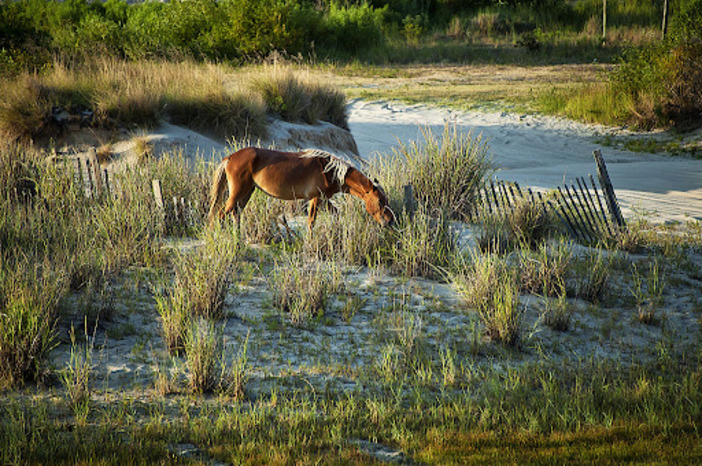
Source: John Greim/LightRocket via Getty Images
They were introduced by the Spanish to the American continent in the 14th century. These beautiful beasts don’t have as many regulated characteristics as their sophisticated counterparts, but because of their wild nature, they don’t need to meet anyone’s standards to be good mounts. Mustangs have strong endurance and long life spans.
Strawberry Roans Forever
We know what you’re thinking now. More roans? How many are there? Well, yes, there are many types, and we simply can’t get enough of these beauties! Strawberry roans are extra-special because their red base color makes them look pink under certain lighting.

Source: Pinterest
When a roan’s skin gets damaged, some marks appear called “corn marks,” and no white hairs grow back in that area. An interesting fact is that we can see roans with corn marks in old paintings that date as far back as the 18th century.
Chocolatey Coating
We dare you to say this horse’s name like a tongue-twister: “Silver dapple sooty buckskin.” It isn’t easy, is it? Well, this charming coat came from a similarly complicated DNA combination, which is why they are considered a graceful oddity.

Source: Pinterest
The silver dapple gene usually affects a black coat; in this case, it’s affecting the sooty buckskin, which develops mainly on the lower part of the body. The reddish mane is a fabulous accent to a wonderful coat. The peculiar light brown spotting reminds us of a chocolate bar with peanut butter spots. Sounds yummy!
Trot the Trot
It’s impossible not to fall in love with this exemplary “grulla.” The stripe on its black makes the breed easy to identify from other solid-coated horses. This type of breed is mostly found in quarter-horses and in other specimens such as buckskins.
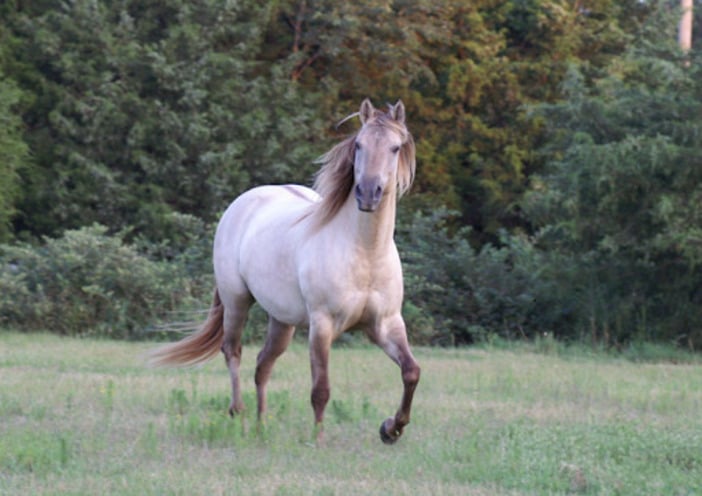
Source: Pinterest
This grullo emanates grace as he trots along the green fields is any horse lover’s dream. The sheer lightness of its gallop is no comparison to other speedy breeds we will learn about further on, though.
Worthy Of A King
This beautiful horse is a Friesian, also known as a Belgian Black. Its silky black coat is nothing short of perfection. This wonderful horse is easy to find appealing, and in Medieval times, these horses were the favorites amongst knights.

Source: Herman Verwey/Foto24/Gallo Images/Getty Images
How imposing would it be to see a fully armed army on top of these stunning creatures? Nowadays the war is over for Friesians, and they are sought after for their gracefulness and talent, especially for dressage competitions. These consist of performing trained movements to pass certain skill tests.
She Is Beauty, She Is Grace
More beautiful coats from the appaloosas! This makes us wonder if other breeds are nearly as photogenic. As you can probably tell by now is that this is an appaloosa roan with a white base and varnish roan.

Source: DeAgostini/Getty Images
Just look at this horse’s grace and sway! Simply gorgeous. After looking at all of these wonderful horses with such intricate and beautiful coats, we simply have to admit that horses are simply the most beautiful animals on earth!
The Traveler
The wonderful black and white mane this Gypsy Cob is showing off isn’t the only trait that makes this horse so special. Gypsies tend to have a beautiful build, which, in modern times, is mostly used as show horses. They have feathered legs and tend to have splashes of white on their otherwise solid coats.

Source: Lyn Alweis/The Denver Post via Getty Images
Their strong physique was perfect for pulling the wagons and caravans some travelers used during the 19th and early 20th centuries in England and Ireland. That’s why these horses are commonly called Gypsy cob, Irish cob, or Gypsy vanner.
An Elegant Stride
Doesn’t this Morgan horse just have an incredible look? And just as fascinating is the experience of riding them. They are a wonderfully graceful breed, famous for their intelligence and curiosity. They are calm-spirited, despite being very strong and fast.

Source: DeAgostini/Getty Images
This sweet-tempered specimen can’t get enough of our love. This type of horse is the subject of literature and a famous poem by Robert Frost. This equine is held in such high regard that it’s the official state horse of three states! Vermont, Massachusetts, and Rhode Island. Everyone wants a little bit of that Morgan horse.
An Exceptional Jumper
Nobody jumps better than a Dutch warmblood. There, we said it! And if you don’t believe us, just look at this beauty. This breed was specifically designed to have exceptional jumping abilities, and that’s why they are also amongst the most expensive horses in the world.

Source: DeAgostini/Getty Images
Dutch warmbloods tend to be solid-colored, with a prevalence of brown, black, chestnut, and gray. Sometimes they have some white markings, but they are never “pintos.” Funnily enough, there has only been one tobiano ever registered, and nobody has dared to breed another one since 1976.
A Natural Work Of Art
This Andalusian with a dapple gray coat is among our top favorites (but aren’t all horses our favorite?). The coat has some wonderful spread-out patterns that look like an intricate work of art. No wonder they have been held in high regard by Spanish nobility since the 14th century.

Source: Ted Streshinsky/CORBIS/Corbis via Getty Images
Andalusians are also known as “pure Spanish horses.” They have gained a lot of popularity in pop culture, having been used in films such as Lord of the Rings, Gladiator, Braveheart, Tomb Raider, and Narnia: The Lion, The Witch, and The Wardrobe.
